- Enumerative bibliographies are lists texts, compiled in alignment with some organizing principle. They sometimes, but not always, distinguish between variant instantiations of the texts they attend to and most importantly serve as handy guides for collectors (working in libraries and privately) and scholars seeking to define a field of inquiry for study or acquisition.
- Bibliographical analysis involves studying the physical clues in textual objects in order to reveal details of the underlying production process.
- Bibliographical description involves describing the paper (or another substrate, for instance parchment, papyrus, or a computer program, supporting the text), letterforms, design, illustrations, structure, binding, and post-publication features of specific textual objects.
- Historical bibliography involves writing narrative histories and technical studies of paper-making, paper use, ink, handwriting, typefaces, type manufacture, book design, typesetting procedures, graphic processes, bookbinding, printing, publishing, bookselling, book collecting, libraries, provenance, and the role of the material text in society and culture–along with biographies of the persons involved in these stories.
- Critical bibliography has been most recently positioned within bibliographical studies in a variety of ways. Scholars and others using this approach draw upon insights from enumerative, analytical, descriptive, and historical bibliographical research to make larger arguments about how textual objects reflect a world that made and kept them. Usually, this involves bringing bibliography into dialogue with twenty-first century humanities scholarship, especially theoretical and critical insights developed therein.
Descriptive bibliography may be defined as the close physical description of books and other printed objects: a systematic report concerning their type, paper, printing, illustrations, and binding, and how the circumstances of their publication and distribution may have affected their physical appearance.
Descriptive bibliographies do most of these things for printed books and other types of textual objects (Belanger and Noble focus on print because that’s what their course focused on) to varying degrees. Above all, individuals consulting a descriptive bibliography can expect a lot of detail and, often, essays offering analysis and contextual background information for the materials described. That said, every descriptive bibliography takes a different approach, tailored to the material under consideration. For this reason, it is always essential to read the introductions and essays accompanying descriptive bibliographies. Checklists, on the other hand, are usually not as detailed, especially with respect to the physical characteristics of the books or other texts described. Checklists are handy for getting acquainted with the range of materials encompassed with a particular subject, genre, or within an author’s or publisher’s oeuvre. They don’t, however, get into the weeds describing details such as (to pick an example at random) binding variants and explaining why those variants exist. JL: What are the newest trends in bibliography? EM: Articles in BSA’s journal, Papers of the Bibliographical Society of America (PBSA), our Fellowship and New Scholars Program winners’ research, and the topics discussed in our robust (and free!) events programming offer an up-to-the-minute snapshot of the field. As a field, trends in bibliography tend to align well with trends in collecting and academia and in many ways the field is wide open! It’s exciting to see so much new research coming to the fore that expands our knowledge of global textual traditions. At the same time, bibliographers continue to explore bibliography’s more traditional areas of focus in British and American literary studies. JL: When was the Bibliographical Society of America established, and what is its mission? EM: The Bibliographical Society of America (BSA) was founded in 1904, incorporated in 1927, and has been busy promoting bibliographical studies and scholarship ever since. BSA is an international, interdisciplinary scholarly organization that fosters the study of books and other textual artifacts in traditional and emerging formats. We pursue this mission by hosting public programs, funding scholarly research, conferring awards, issuing publications, and collaborating with related organizations. For many years BSA’s activities focused on publications, and the Society funded and encouraged many important works in the field from Margaret Stillwell’s (and then Frederick R. Goff’s) Incunabula in American Libraries to the Bibliography of American Literature, edited by Jacob Blanck and others. Publishing remains and important part of BSA’s activities, and we have expanded our reach to the digital with BibSite, a free resource for the study and teaching of bibliography. In the late 20th century the Society expanded its programs, establishing research Fellowships and promoting work by emerging scholars in the field through the New Scholars Program. More than 20% of the Society’s annual budget is spent on direct expenses related to these initiatives each year. Hundreds of students, professors, librarians, booksellers, collectors, and independent scholars have received fellowship awards, and their research appears in the books and articles published by the Society and others. Most recently, the BSA has expanded its public programming, offering panels and lectures throughout the year on bookish and bibliographical subjects. All are welcome to attend most of our sponsored events, which you can learn about and register for at https://bibsocamer.org/programs/upcoming-events. JL: From a collector’s point of view, what are the benefits of joining the BSA? EM: We get it – BSA membership must be worth your while! Let’s talk about all of the ways that BSA membership is a symbiotic relationship: you support the organization and we support you as a member. Collectors, our membership benefits are definitely tailored to your needs.- First and foremost, BSA members are part of a community of people who love learning about books and other kinds of textual objects. Their professional backgrounds are as diverse as their bookish interests. The barrier for entry is low: anyone can join at any time. Dues start at $25/year for individuals 35 and younger, and $80/year for everyone else.
- Free access to PBSA in print and online. The journal keeps collectors up to date with what’s happening in the field, from cutting-edge research articles to book reviews. Members have access to the full archive of PBSA online as well as ebook files for the latest issues.
- Affordable opportunities to learn more about books and how they are made with member discounts on virtual and in-person classes at the Center for Book Arts.
- Collectors don’t just build libraries, they use them! BSA offers members discounted access to research support – interlibrary loan, JStor, and personal reference services – through a special membership program with the New York Society Library and the ACLS Humanities eBook Platform.
- Coming soon: a special member directory for BSA members only on our new website.




